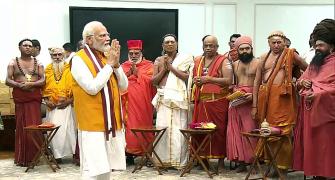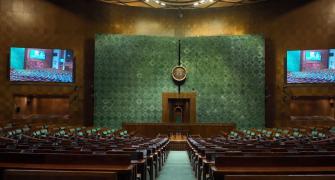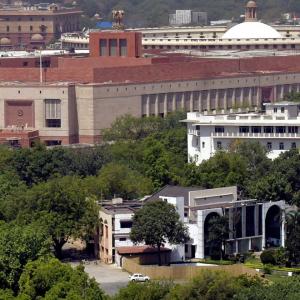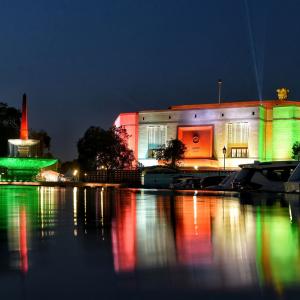Prime Minister Narendra Modi inaugurated the new Parliament building in New Delhi on Sunday morning and expressed hope that it will become a cradle of empowerment, igniting dreams and nurturing them into reality.
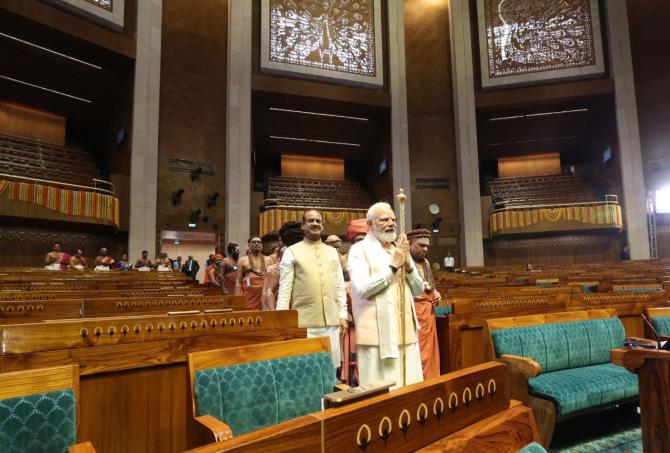
Dressed in traditional attire, Modi walked into Parliament premises from its Gate No. 1 and was welcomed by Lok Sabha Speaker Om Birla.
Amid Vedic chants by priests from Karnataka's Shringeri Math, the prime minister performed "Ganapati Homam" to invoke divine blessings.
The prime minister prostrated before the Sengol and sought blessings from high priests of various adheenams in Tamil Nadu with the holy sceptre in hand.
Modi then carried the Sengol in a procession amid tunes of nadaswaram and chanting of Vedic mantras to the new Parliament building and installed it in a special enclosure on the right side of the Speaker's chair in the Lok Sabha chamber.
"As the new building of India's Parliament is inaugurated, our hearts and minds are filled with pride, hope and promise. May this iconic building be a cradle of empowerment, igniting dreams and nurturing them into reality. May it propel our great nation to new heights of progress," the prime minister tweeted later.

He also shared pictures of the inaugural event held this morning.
Several Union ministers, including Rajnath Singh, Amit Shah, S Jaishankar, Ashwini Vaishnaw, Mansukh Mandaviya and Jitendra Singh, Uttar Pradesh Chief Minister Yogi Adityanath, Assam Chief Minister Himanta Biswa Sarma, BJP president J P Nadda among others were present on the occasion.
The prime minister felicitated with shawls and souvenirs some of the workers for their key role in the construction of the new Parliament building.
A multi-faith prayer was also held to mark the occasion.
The prime minister, along with the Speaker and some other dignitaries, later went to the old Parliament House.
The events to mark the inauguration are being held amid a boycott by several Opposition parties which insist that President Droupadi Murmu as the Head of the State should do the honours.

The new Parliament building, constructed by Tata Projects Ltd, will also have a grand Constitution Hall to showcase India's democratic heritage, a lounge for MPs, a library, multiple committee rooms, dining areas and ample parking space.
The triangular-shaped four-storey building has a built-up area of 64,500 square metres.
The building has three main gates -- Gyan Dwar, Shakti Dwar, and Karma Dwar.
It will have separate entrances for VIPs, MPs and visitors.
The material used for the new building has been acquired from various parts of the country.
The teakwood used in the building was sourced from Nagpur in Maharashtra, while the red and white sandstone was from Sarmathura in Rajasthan. The sandstone for the Red Fort and Humayun's Tomb in the national capital was also known to have been sourced from Sarmathura.

The Kesharia green stone has been procured from Udaipur, the red granite from Lakha near Ajmer and the white marble has been sourced from Ambaji in Rajasthan.
"In a way, the entire country came together to construct the temple of democracy, thus reflecting the true spirit of Ek Bharat Shreshtha Bharat," an official said.
The steel structure for the false ceilings in the Lok Sabha and the Rajya Sabha chambers has been sourced from the Union territory of Daman and Diu, while the furniture in the new building was crafted in Mumbai.
The stone 'jaali' (lattice) works dotting the building were sourced from Rajnagar in Rajasthan and Noida in Uttar Pradesh.

The materials for the Ashoka Emblem were sourced from Aurangabad in Maharashtra and Jaipur in Rajasthan, while the Ashok Chakra donning the massive walls of the Lok Sabha and the Rajya Sabha chambers and the exteriors of the Parliament building were from Indore in Madhya Pradesh.
The new Parliament building used manufactured sand or M-sand from Charkhi Dadri in Haryana in the concrete mix for the construction activities.
M-Sand is considered environmentally friendly as it is manufactured by crushing large hard stones or granite and not by dredging river beds.
The fly ash bricks used in the construction were sourced from Haryana and Uttar Pradesh, while brass works and pre-cast trenches were from Ahmedabad in Gujarat.
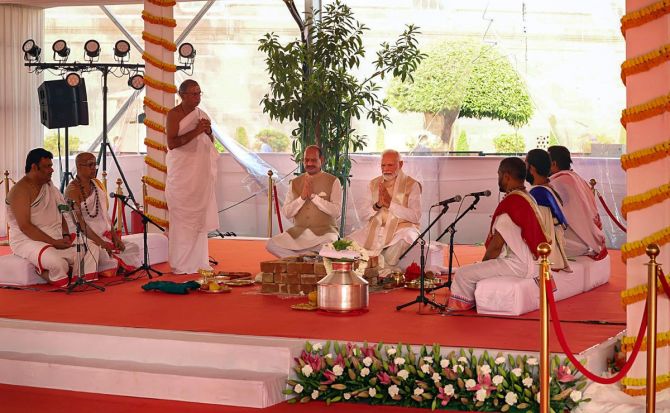
Built at an estimated cost of Rs 1200 crore, the new Parliament building can comfortably seat 888 members in the Lok Sabha chamber and 300 in the Rajya Sabha chamber.
In the case of a joint sitting of both Houses, a total of 1,280 members can be accommodated in the Lok Sabha chamber.
The prime minister laid the foundation stone of the new Parliament building, a key component of the ambitious Central Vista project, on December 10, 2020. The construction work started in early 2021 and took a little over two years to complete.
The present Parliament building was completed in 1927 and is now 96 years old.
Over the years, the old building was found to be inadequate for the present day requirements.
Lok Sabha and Rajya Sabha had passed resolutions urging the government to construct a new building for Parliament.

The existing building served as independent India's first Parliament and witnessed the adoption of the Constitution.
Originally called the Council House, the building housed the Imperial Legislative Council. The Parliament building witnessed the addition of two floors in 1956 to address the demand for more space.
In 2006, the Parliament Museum was added to showcase the 2,500 years of rich democratic heritage of India.
Officials said the old building was never designed to accommodate a bicameral legislature and the seating arrangements were cramped and cumbersome, with no desks beyond the second row.
The Central Hall in the old Parliament building has a seating capacity only for 440 people and the need for more space was acutely felt during joint sittings of both houses.


